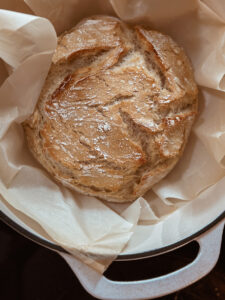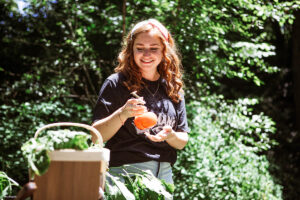
When I was a boy we would occasionally make a meal out of apple butter on bread, doused with fresh, rich, Jersey milk. Not just a little bit of apple butter either. The bread was placed in a dish, and a big dollop of apple butter was spread on it, followed by the milk. It was quick and easy, and delicious too. Our apple butter was always store-bought though, and I wasn’t even aware that some people made their own.
That changed when we moved to Wayne County, and we learned that one of the families in our church made their own apple butter in a large copper kettle over a wood fire, and they shared some with us. For them, it was a tradition passed down from previous generations.
Since that time I’ve learned that (in these parts at least) making apple butter is a long-standing tradition for many Amish families, and some Mennonites too. When I married into this Swiss Mennonite and Amish community, it was a great delight to learn that my wife’s family did this every fall. Joining them for this annual event was something to look forward to.
On a Friday evening in October or November, apples from the home orchard would be schnitzed in preparation for the apple butter. “Schnitz” is the word that’s always used for the process of peeling, coring, and quartering the apples. It’s a German word that means “carving.”

My Swiss in-laws have those old-fashioned peelers like Lehman’s manufactures and sells, and on schnitz day, the older kids did the peeling as the adults quartered and cored. It was a family project that included everyone. The next morning the fire was started, and cider was boiled down in the kettle. This would add extra apple flavor to the finished product. Next the apples were added, and later in the afternoon, sugar was added. By early evening, after cooking and stirring all afternoon, the apple butter was ready for canning, and an assembly line formed to dip the apple butter into jars, wipe stray drips from the jar tops, add rings and lids, and move the jars out of the way.

In later years, the process was streamlined somewhat. A hand-cranked strainer was used to quickly produce applesauce that was then used instead of schnitzed apples. No more peeling necessary, and the end product was the same. Those were great family times, with many pleasant memories of tending the fire and taking turns stirring the apple butter with a long-handled paddle that had a lot of holes in it.
We haven’t done it for a number of years, and I miss those days, but it is still possible to enjoy the same apple butter by making it right at home in our kitchen. The flavor is the same, and the ratio of ingredients is the same — only using a fraction of the apples, cider, and sugar than are cooked in the large copper kettle.

A few days ago, my wife and I made applesauce from one-half bushel of Honey Crisp apples. It made twenty pounds of apple sauce, (a little over two gallons), and while it was still hot, it was poured into a large roaster and placed into our oven that was heated to 300 degrees. At the same time, I began cooking down two gallons of cider to quickly reduce it to less than one gallon before adding it to the sauce.

Approximately eight hours later, after stirring the sauce once an hour with a silicone spatula, it was time to add six cups of sugar, and begin testing it for completion. This is easy. You simply put a spoonful of apple butter in a dish and watch for liquid to run out of it. If there is still quite a bit of liquid, keep it in the oven a while longer. Test it every half hour or so. It is finished and ready for canning when very little juice runs from the spoonful of apple butter in the dish.

I like to use a small kettle to dip the apple butter, and using a jar-funnel, fill pint or quart jars. Quickly and firmly a cap and ring are turned on, and the jar is set to the side. It is good to have two people working at this in order to get the job done more quickly before the apple butter cools down too much to seal the jars.
The apple butter is delicious! It is thick and rather coarse too, not at all like the finely pureed store-bought product. Some people like to season it with cinnamon and other spices, but we prefer the straight apple butter with no additional seasoning. Apple butter is amazingly delicious when hot and fresh, slathered generously on buttered homemade bread. Kingly food!

Our one-half bushel of apples produced eleven pints of the good stuff. This will be plenty to get us through until next fall. One more note: we generally use Grimes Golden apples, but decided to try Honey Crisp this year. The flavor turned out a little sharper and potent this time. Still excellent, but I think we’ll go back to Grimes Golden next year.
Any size batch can be made in the oven, and a smaller roaster can be used. Some folks even use cookie sheets for very small batches. There should be equal parts of sweet cider and applesauce, with sugar added to suit your individual taste.
For example:
One gallon cider
One gallon applesauce
Approx. 3 cups sugar
(This size batch will make about 5-6 pints apple butter.)
































[…] ‘EM Apple butter is a uniquely delicious, almost decadent creation and surprisingly easy to make; after all it has […]